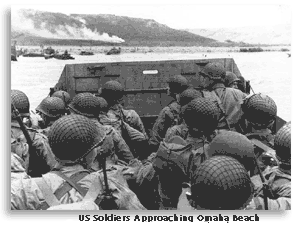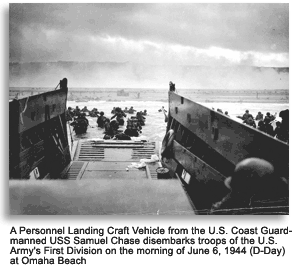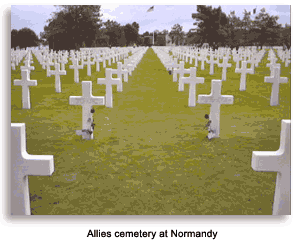The Battle of Normandy was fought during World War II in the summer of 1944, between the Allied nations and German forces occupying Western Europe. More than 60 years later, the Normandy Invasion, or D-Day, remains the largest seaborne invasion in history, involving nearly three million troops crossing the English Channel from England to Normandy in occupied France.
 Twelve Allied nations provided fighting units that participated in the invasion, including Australia, Canada, Belgium, France, Czechoslovakia, Greece, New Zealand, the Netherlands, Norway, Poland, the United Kingdom, and the United States.
Operation Overlord was the codename for the Allied invasion of northwest Europe. The assault phase, or the establishment of a secure foothold, was known as Operation Neptune. Operation Neptune began on D-Day (June 6, 1944) and ended on June 30, when the Allies had established a firm foothold in Normandy. Operation Overlord also began on D-Day, and continued until Allied forces crossed the River Seine on August 19.
The battle began months before the invasion, when Allied bombers began to pound the Normandy coast and farther south, to destroy transportation links, and disrupt the German army's build-up of their military strength. More than 300 planes dropped 13,000 bombs over Normandy in advance of the invasion. Six parachute regiments, with more than 13,000 men, also went ahead to cut railroad lines, blow up bridges, and seize landing fields. Gliders also brough in men, light artillery, jeeps, and small tanks.
Twelve Allied nations provided fighting units that participated in the invasion, including Australia, Canada, Belgium, France, Czechoslovakia, Greece, New Zealand, the Netherlands, Norway, Poland, the United Kingdom, and the United States.
Operation Overlord was the codename for the Allied invasion of northwest Europe. The assault phase, or the establishment of a secure foothold, was known as Operation Neptune. Operation Neptune began on D-Day (June 6, 1944) and ended on June 30, when the Allies had established a firm foothold in Normandy. Operation Overlord also began on D-Day, and continued until Allied forces crossed the River Seine on August 19.
The battle began months before the invasion, when Allied bombers began to pound the Normandy coast and farther south, to destroy transportation links, and disrupt the German army's build-up of their military strength. More than 300 planes dropped 13,000 bombs over Normandy in advance of the invasion. Six parachute regiments, with more than 13,000 men, also went ahead to cut railroad lines, blow up bridges, and seize landing fields. Gliders also brough in men, light artillery, jeeps, and small tanks.
There has been some confusion regarding the meaning of the “D” in D-Day. The most likely explanation is offered by the U.S. Army in their published manuals. The Army began to use the codes “H-hour” and “D-Day” during World War I, to indicate the time or date of an operation’s beginning. So the “D” may simply refer to the “day” of invasion.
With the invasion of Normandy, General Dwight D. Eisenhower faced a task of magnitude and hazards never before attempted. He would have to move his forces 100 miles across the English Channel and storm a heavily fortified coastline. His enemy was the weapon-and-tank-superior German army commanded by Erwin Rommel, one of the most brilliant generals of the war. Less than 15 percent of the Allied forces coming aboard the ships had ever seen combat.
 An invading army had not crossed the unpredictable and dangerous English Channel since 1688. Once the massive Allied force set out, there was no turning back. The Allies boasted a 5,000-vessel armada that stretched as far as the eye could see, transporting both men and vehicles across the channel to the French beaches. In addition, the Allies had 4,000 smaller landing craft and more than 11,000 aircraft.
By nightfall on June 6, more than 9,000 Allied soldiers were dead or wounded, but more than 100,000 had made it ashore and secured French coastal villages. Within weeks, supplies were being unloaded at Utah and Omaha beachheads at the rate of more than 20,000 tons per day. By June 11, more than 326,000 troops, 55,000 vehicles, and 105,000 tons of supplies had been landed on the beaches. By June 30, the Allies had established a firm foothold in Normandy. Allied forces crossed the River Seine on August 19.
An invading army had not crossed the unpredictable and dangerous English Channel since 1688. Once the massive Allied force set out, there was no turning back. The Allies boasted a 5,000-vessel armada that stretched as far as the eye could see, transporting both men and vehicles across the channel to the French beaches. In addition, the Allies had 4,000 smaller landing craft and more than 11,000 aircraft.
By nightfall on June 6, more than 9,000 Allied soldiers were dead or wounded, but more than 100,000 had made it ashore and secured French coastal villages. Within weeks, supplies were being unloaded at Utah and Omaha beachheads at the rate of more than 20,000 tons per day. By June 11, more than 326,000 troops, 55,000 vehicles, and 105,000 tons of supplies had been landed on the beaches. By June 30, the Allies had established a firm foothold in Normandy. Allied forces crossed the River Seine on August 19.
 Military intelligence was an important part of the Normandy invasion. British and American cryptographers working in London deciphered coded messages that the German believed to be unbreakable. Messages could quite often be delivered to Eisenhower within two and a half hours of the time the Germans had sent it. In addition, reconnaissance teams took infrared pictures of Omaha Beach while avoiding German patrols.
There is no official casualty figure for D-Day. It is estimated that more than 425,000 Allied and German troops were killed, wounded, or went missing during the battle. That figure includes more than 209,000 Allied casualties. In addition to roughly 200,000 German troops killed or wounded, the Allies also captured 200,000 soldiers. Captured Germans were sent to American prisoner-of-war camps at the rate of 30,000 per month, from D-Day until Christmas 1944. Between 15,000 and 20,000 French civilians were killed during the battle.
Military intelligence was an important part of the Normandy invasion. British and American cryptographers working in London deciphered coded messages that the German believed to be unbreakable. Messages could quite often be delivered to Eisenhower within two and a half hours of the time the Germans had sent it. In addition, reconnaissance teams took infrared pictures of Omaha Beach while avoiding German patrols.
There is no official casualty figure for D-Day. It is estimated that more than 425,000 Allied and German troops were killed, wounded, or went missing during the battle. That figure includes more than 209,000 Allied casualties. In addition to roughly 200,000 German troops killed or wounded, the Allies also captured 200,000 soldiers. Captured Germans were sent to American prisoner-of-war camps at the rate of 30,000 per month, from D-Day until Christmas 1944. Between 15,000 and 20,000 French civilians were killed during the battle.
 In the end, the invasion of Normandy succeeded in its objective by sheer force of numbers. By July 1944, some one million Allied troops, mostly American, British, and Canadian, were entrenched in Normandy. During the great invasion, the Allies assembled nearly three million men and stored 16 million tons of arms, munitions, and supplies in Britain.
The occupation of Normandy was crucial for the Western Allies to bring the war to the western border of Germany. If the Normandy invasion had not occurred, there could conceivably have been a complete possession of northern and western Europe by Soviet forces.
In the end, the invasion of Normandy succeeded in its objective by sheer force of numbers. By July 1944, some one million Allied troops, mostly American, British, and Canadian, were entrenched in Normandy. During the great invasion, the Allies assembled nearly three million men and stored 16 million tons of arms, munitions, and supplies in Britain.
The occupation of Normandy was crucial for the Western Allies to bring the war to the western border of Germany. If the Normandy invasion had not occurred, there could conceivably have been a complete possession of northern and western Europe by Soviet forces.